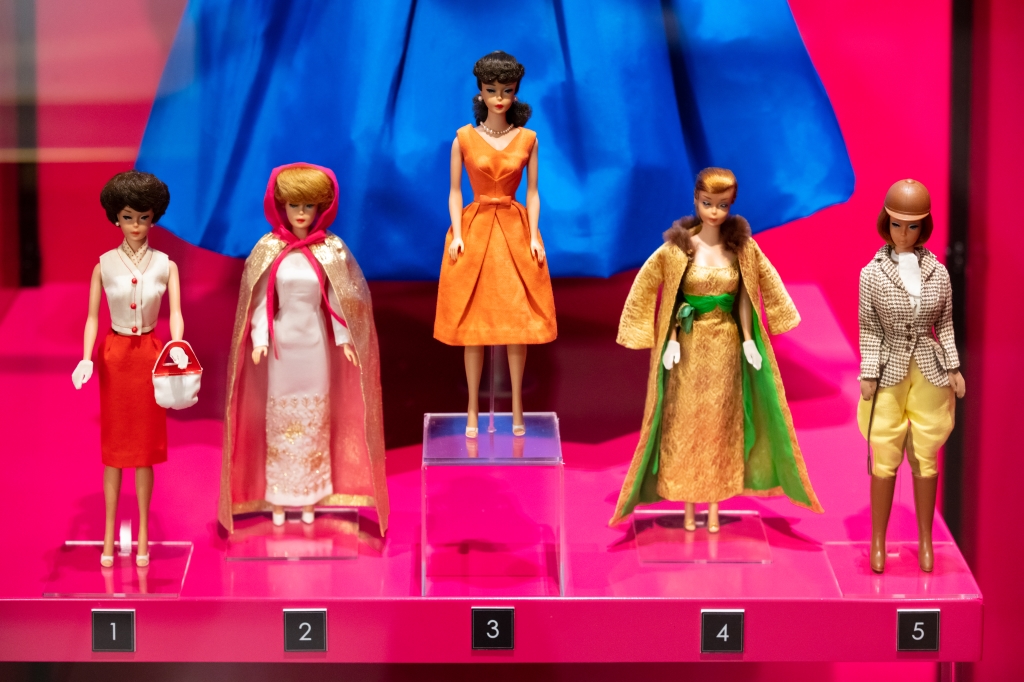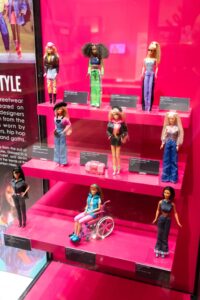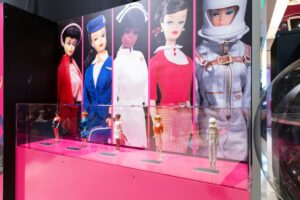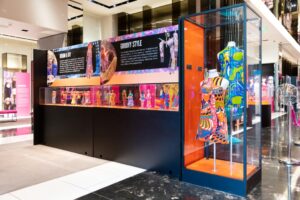Pretty in Pink

Writer Rebecca L. Rhoades // Photography by Jason Harper Photography and Courtesy of Illusion Projects and Mattel



2023 was the year of Barbie. The 11.5-inch plastic doll has enchanted little girls and collectors for more than six decades. But last year, the blond-haired, blue-eyed beauty went from iconic plaything to cultural zeitgeist, thanks to the release of Greta Gerwig’s award-winning blockbuster of the same name. Amassing more than $1.4 billion in ticket sales, “Barbie” was the highest-grossing movie of the year and Warner Bros.’ highest-grossing movie of all time. Everywhere you looked, from outfits to interiors, Barbiecore dominated.
Now, a new museum exhibition explores the story of Barbie’s evolution through the lens of fashion and design.
Developed in collaboration with creative design and production company Illusion Projects and toy company Mattel, “Barbie: A Cultural Icon” at Phoenix Art Museum “examines the Barbie brand’s 60-plus-year history and the doll’s global impact on pop culture through a wide-ranging showcase of more than 250 vintage dolls, life-size fashion designs, exclusive interviews and narrative sections that consider the style trends, careers and identities that Barbie has embodied and popularized over the decades.”
Author and costume historian Karan Feder curated the traveling exhibit, which debuted in Las Vegas in October 2021. Many of the dolls and artifacts on display come from the private collection of Las Vegas resident David Porcello.
“David is a collector of vintage fashion, and part of that is miniature Barbie fashions,” Feder says. “His collection is unique because it fits into a silo. He is interested in collecting only the fashions, not really the dolls, from 1959, when Barbie was first introduced, to 1999. His goal is to collect every single piece of fashion made for Barbie during that period of time.”
Unlike today, when new outfits, especially limited-edition designer outfits, come packaged on dolls, early Barbie fashions were sold separately. The first doll was marketed in the now instantly recognizable black-and-white striped jersey swimsuit.
Feder notes in her recently released coffee table book, “Barbie Takes the Catwalk,” that Barbie’s first wardrobe consisted of “22 marvelously designed ensembles priced between $1 and $5.” These and the rest of Barbie’s sartorial canon are on display, juxtaposed with full-size human fashions from the same eras.



65 Years of Style
Barbie burst onto the shelves in 1959. Her creator, Ruth Handler, co-founder of Mattel, named the doll after her daughter, Barbara. Often known as the first fashion doll, Barbie instantly became a cultural phenomenon. Her stylish outfits, glamorous lifestyle and ever-changing persona captured the imagination of generations — including some of the world’s top fashion designers.
The first designer to receive credit on Barbie’s box was Oscar de la Renta in the mid-1980s, but the mini fashion icon’s closet was already filled with outfits that were influenced by celebrities and catwalks around the world. From minimalist, elegant frocks inspired by Oleg Cassini’s designs for first lady Jacqueline Kennedy to the exaggerated sleeve and shoulder treatments favored by Nolan Miller and Emanuel Ungaro in the 1980s, Barbie’s fashions have always followed current trends.
“Barbie’s offerings change with time based on who the popular designers of the moment are,” Feder explains. “Her evolution and fashion really are a little microcosm of the evolution in Western fashion over the similar time period.”
The museum exhibition traces this evolution, spotlighting diverse characters within the Barbie universe and connecting them to contemporary fashion trends, perspectives and identities.
“The really fascinating thing about this exhibit that no other Barbie exhibition has done is this concept of showing vintage fashion as it relates to Barbie fashion side by side,” Feder says. “So you can say, ‘Oh yeah, I totally get why that Barbie fashion happened.’”
In a press release announcing the exhibition at Phoenix Art Museum, Helen Jean, the museum’s Jacquie Dorrance curator of Fashion Design, said, “Barbie has always been associated with innovative fashion, wearing pantsuits and dresses, rollerblades and workout clothes, right in line with the trends of the time. Over the past decade, however, we’ve seen Barbie shift from a mirror of trends to a trendsetter, no longer simply wearing the silhouettes and styles most prominently promoted to girls and women but instead dictating what those fashions are or can be. She’s inspired runway fashion collections over the last 10 years.”
“Barbie: A Cultural Icon” is divided into six distinct sections: the doll’s origin story and all 22 original ensemble outfits; the influence of the Space Age; the creation of Christie, the first Black doll; the arrival of Ken; and the creation of the Barbie Dreamhouse.
Visitors will see the iconic fashions of the 1970s, including Groovy Style, beachwear and disco-themed designs. The 1980s and ’90s present a selection of diverse dolls that represent a range of ethnicities, body types and careers. The exhibition culminates in the 2000s, spotlighting the continued diversification of characters within the Barbie universe and connecting them to contemporary fashion trends.
Also on display will be more than 50 historical objects and life-size fashion designs, video interviews with Barbie designers on five custom-made Barbie Dreamhouse TVs, and even a life-size Barbie Mirror-Pink Corvette in which guests can take photos.
Many of the pieces in the exhibition are being displayed for the very first time.
“There are some pieces that Mattel didn’t even recognize,” Feder says. “They were so obscure that Mattel was like, ‘We’ve never even seen that piece before!’ That’s cool.”
“There are so many items to look at. But one of my favorite things is when a person stops in front of one piece and says, ‘Oh my God, I remember that one!’ All of a sudden, they’re brought back to exactly when they were 9 years old, and they remember that one outfit that they just adored. So there are those nostalgic moments that you will come across as you traverse through the exhibition. When you’re least expecting it, you’ll be brought back to your childhood.”



The Power of Pink
Just like 2023 was the year of Barbie, it was also the year of pink. In Greta Gerwig’s film, everything from the fantastical world of Barbie Land to the costumes of its lead characters were awash in the bright, feminine hue. Star Margot Robbie even stole the spotlight at every premiere thanks to her wardrobe influenced by classic Barbie-pink fashions.
As a result, the color — Pantone 219 C — was suddenly popping up everywhere, especially on clothing. The Phoenix Art Museum is celebrating the complex history of this color with “The Power of Pink,” a new exhibition that complements “Barbie: A Cultural Icon.”
According to the museum, the exhibition “traces the history of the hue and the evolution of its role in fashion, from its origins in 17th-century France, where it was worn by both men and women of status, luxury and power, to 1940s North America, when mass-marketing efforts began to gender the color, assigning pink to girls and blue to boys.”
For Feder, the ancillary exhibit will further explore Barbie and fashion, tying the two together through the evolution of the color.
“Because so much of this exhibit shows life-size, human-size vintage fashion next to Barbie fashion, it allows museums with costume and textile collections to bring out pieces from their own archives and showcase them next to Barbie pieces from the era to make their own connections,” Feder says. “The Phoenix Art Museum is able to do this because they have such a world-class costume collection, and it’s a super-exciting extension of this touring exhibition.”
Garments by renowned designers such as Gianfranco Ferré, Christian Dior, Valentino, Yves Saint Laurent and more will be on display.
“Our presentation of ‘Barbie: A Cultural Icon’ offers a timely opportunity for us to draw upon our incredible fashion-design collection to explore Barbie’s favorite color,” said curator Helen Jean in a press release. “Just like Barbie, the color pink sparks conversations, and just like Barbie, pink is having its day in the spotlight. We look forward to considering the history, politics and science behind this popular yet polarizing color.”
Feder notes that early dolls had more red and black clothes than they did pink ones. She says that it wasn’t until the late 1980s–early ’90s that the bubblegum hue became forever associated with Barbie. In 2023, Pantone, which provides color standards for everything from graphic design to fashion, named its Barbie Pink the Color of the Year.
“Barbie Pink is uplifting and inspires confidence, courage, vigor and vibrancy — everything we need in a post-pandemic world,” the company says. “People want to escape, and they are latching onto something colorful and nostalgic and playful. When you think about color being a language that expresses what is taking place, this dynamic, energizing pink and its association with Barbie is about being daring and unafraid and taking chances.”
Barbie: A Cultural Icon
Through July 7 // See website for hours // Phoenix Art Museum // 1625 N. Central Ave., Phoenix // See website for price // phxart.org
